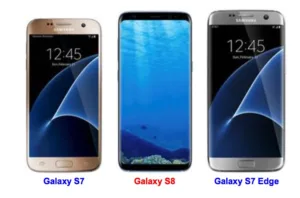In the latest instalment of a seven year run at evaluating mobile displays for the smartphone market, DisplayMate Labs principal, Dr. Ray Soneira, said that Samsung’s 3K pixel ( 2960 x 1440 ) mobile AMOLED displays now hold a “commanding lead” over similar sized LCDs. The good doctor’s comment was made in today’s publication of the Samsung Galaxy S8 display technology shoot-out by DisplayMate Labs.

In his latest DisplayMate Shoot-out installment, Soneira called the mobile device display “the crown jewel of the smartphone.” He was referencing the new Samsung Galaxy S8 and S8+ that feature a “…radical new Full Display Screen design that fills almost the entire front face of the phone, providing a significantly larger display for the same size phone,” Soneira wrote of the Samsung 2960 x 1440 pixel marvel.
The 5.8- and 6.2-inch diagonal displays feature 570 pixels per inch displaying more than four complete HD 1280×720 images at once. Both use sub-pixel rendering that, “…further improves image sharpness because the individual red, green and blue sub-pixels are treated as independent addressable image elements and are not bound together into fixed pixels, so the closest sub-pixel is used when rendering the image,” that offers up to 3x the resolution of traditional pixel rendering, according to Soneira. He also concludes it’s “…absolutely pointless” to increase the display resolution any further–to 4K for instance, calling that effort a “silly marketing wild goose chase into the stratosphere.”
Part of the appeal of this design is the flexible curved OLED screen (encased in a rigid hard glass) that provides two new user configurable surfaces on the edge of the screen. They can be viewed “…from both the front or the sides, and even when the phone is placed face down,” he said. In “Always-On” mode, the edge screen of the Galaxy S8 can serve as a night clock (or perhaps even night light) for the bedside table.
Highlights of the new Samsung Galaxy S8 and S8+ displays include:
- A new 3K Higher Resolution 2960 x 1440 display that fills almost the entire front face of the phone from edge-to-edge (creates a larger 5.8 inch display with a taller height to width aspect ratio of 18.5 : 9 = 2.05)
- A full 100% DCI-P3 color gamut thahdrt is also used for 4K TVs. (Soneira notes this is the first Smartphone to be certified by the UHD Alliance for mobile HDR premium, allowing it to play all of the latest content produced for 4K UHD premium TVs). The native color gamut of the Galaxy S8 is even larger, due to its new high saturation “Deep Red” OLED, with 113% of DCI-P3, 142% of sRGB / Rec.709 Gamuts. It also produces “…better on-screen colors in high ambient light that improves screen visibility and brightness needed for HDR,” Soneira stated.
- Screen brightness is enhanced by 5% to 19%, and the new display holds a new record peak brightness of over 1,000 cd/m² according to the report.
- Video enhancer that provides HDR-like expanded dynamic range for photos and videos not featuring the HDR coding.
- User adjustable white point with RGB color balance slider controls adjust the color of white for the adaptive display screen mode.
- Front and back dual ambient light sensors offer a “significantly improved” auto brightness feature.
- Night mode uses a blue light filter to adjust and reduce the level of blue light from the display (gives a better night viewing plus improved sleeping experience.)
 DisplayMate Labs gives an A+ rating to the 3K ( 2960 x 1440 pixel) AMOLED display found in the new Samsung flagship Galaxy S8 and S8+ smartphonesSuffice it to say, Samsung is leaving nothing to chance with the launch of its newest flagship Galaxy S8 and S8+ smartphones. From the looks of this remarkable display, the company concurs with Soneira giving full attention and focus on the “crown jewel” of the device, the mobile AMOLED display. Perhaps this is also why rumors abound over the imminent launch of Apple’s Gen 10 iPhone (8?) with claims it features a first-time ever AMOLED display.
DisplayMate Labs gives an A+ rating to the 3K ( 2960 x 1440 pixel) AMOLED display found in the new Samsung flagship Galaxy S8 and S8+ smartphonesSuffice it to say, Samsung is leaving nothing to chance with the launch of its newest flagship Galaxy S8 and S8+ smartphones. From the looks of this remarkable display, the company concurs with Soneira giving full attention and focus on the “crown jewel” of the device, the mobile AMOLED display. Perhaps this is also why rumors abound over the imminent launch of Apple’s Gen 10 iPhone (8?) with claims it features a first-time ever AMOLED display.
While the scope of this article only allows us to touch the surface of this remarkable new technology, fortunately, the DisplayMate Labs shoot-out delves into the full range of precise detail and subjective analysis that only Dr. Ray can provide. So don’t miss the his full article on the Galaxy S8 OLED display shoot-out. – Stephen Sechrist
Also, some shameless self promotion. Just when you thought you were up to speed, here are some other related articles of interest (subscription may be required-but it’s well worth it):
DisplayMate Looks to the Smartphone Future
Samsung Launches New VR Platform Featuring Premium Content and Experiences
Discover New Possibilities With the Samsung Galaxy S8 and Galaxy S8+: a Smartphone Without Limits
Samsung Pushed Resolution at MWC
Samsung Reacts to Positive LG G6 Sales
Samsung Finds Some Products to Launch
Samsung to Produce Prototypes of Foldable Smartphones in 3Q2017
Flexible AMOLED Display Revenues to Overtake Rigid Revenues
China’s BOE to have world’s largest TFT-LCD+AMOLED capacity in 2019
AUO Resumes Production of AMOLED Smartphone Panels
China to Expand AMOLED Panel Production
Samsung Display Plans AMOLED Expansion in Vietnam

